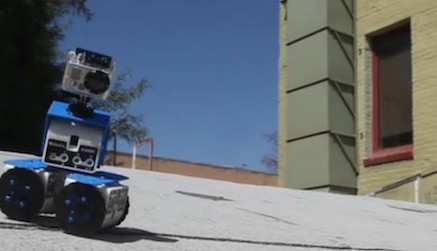Linkbot: The Hackable Modular Robot for Everyone
June 05, 2013
on
on

Linkbot is a modular robotic platform designed to be easy enough for kids and beginners yet challenging enough for advanced designers creating their own complex robotic systems.
There are two kinds of DYI robotic systems according to Linkbot developer Graham Ryland, those which are easy to understand but have limited capabilities and those which are versatile but difficult to master. The goal of Linkbot is to bridge the two extremes.
Linkbot is the brainchild of Engineering professor Harry Cheng and Graham Ryland his former graduate student. They developed the platform at the University of California, Davis. In 2010 they founded the company Barobo to make the robot commercially available. Having gone through the prototype phase they are now running a $40,000 Kickstarter campaign to start mass production.
A single Linkbot has three mounting surfaces to attach modules or accessories like wheels or grippers. There’s a snap-on system for quick plug and play or you can use standard screws to connect self-made add-ons.
The real fun starts when you get two modules or more. You can connect them to create a larger system or use the modules’ ZigBee capable radio to let them wirelessly communicate. Using one module to remotely control the others you can go for a stroll accompanied by your own robot swarm.
What makes Linkbot easy enough for kids to play with is PoseTeach. Kids can manually run the robot through a set of motions and record each step. It enables them to generate robot behavior hands-on instead of from behind a computer screen. BumpConnect wirelessly pairs two modules by simply bumping them together.
When ready to dive deeper into robotics there’s the open source RoboLink software. The behavior recorded in PoseTeach can be imported into RoboLink which converts it into code (Python or C). You can paste the code into the editor and tinker with it. Other features of the software are controlling the robot's motor speeds, power and LED color and monitoring sensors.
For advanced users there is the option to use the I2C bus to connect external devices such as sensors or the Linkbot USB and breakout boards. The Atmel AVR Microcontroller is Arduino-compatible and comes with a bootloader which makes it possible to overwrite the existing firmware.
Barobo supports a community website where users can share accessory models and code. Barabo’s own accessories are also made available for home 3D printing.
At time of writing the Kickstarter campaign is halfway meeting its goal. You can support the project for as little as $10 but when you pledge $139 you’ll be rewarded with one Linkbot module, for $299 you’ll get two.
There are two kinds of DYI robotic systems according to Linkbot developer Graham Ryland, those which are easy to understand but have limited capabilities and those which are versatile but difficult to master. The goal of Linkbot is to bridge the two extremes.
Linkbot is the brainchild of Engineering professor Harry Cheng and Graham Ryland his former graduate student. They developed the platform at the University of California, Davis. In 2010 they founded the company Barobo to make the robot commercially available. Having gone through the prototype phase they are now running a $40,000 Kickstarter campaign to start mass production.
A single Linkbot has three mounting surfaces to attach modules or accessories like wheels or grippers. There’s a snap-on system for quick plug and play or you can use standard screws to connect self-made add-ons.
The real fun starts when you get two modules or more. You can connect them to create a larger system or use the modules’ ZigBee capable radio to let them wirelessly communicate. Using one module to remotely control the others you can go for a stroll accompanied by your own robot swarm.
What makes Linkbot easy enough for kids to play with is PoseTeach. Kids can manually run the robot through a set of motions and record each step. It enables them to generate robot behavior hands-on instead of from behind a computer screen. BumpConnect wirelessly pairs two modules by simply bumping them together.
When ready to dive deeper into robotics there’s the open source RoboLink software. The behavior recorded in PoseTeach can be imported into RoboLink which converts it into code (Python or C). You can paste the code into the editor and tinker with it. Other features of the software are controlling the robot's motor speeds, power and LED color and monitoring sensors.
For advanced users there is the option to use the I2C bus to connect external devices such as sensors or the Linkbot USB and breakout boards. The Atmel AVR Microcontroller is Arduino-compatible and comes with a bootloader which makes it possible to overwrite the existing firmware.
Barobo supports a community website where users can share accessory models and code. Barabo’s own accessories are also made available for home 3D printing.
At time of writing the Kickstarter campaign is halfway meeting its goal. You can support the project for as little as $10 but when you pledge $139 you’ll be rewarded with one Linkbot module, for $299 you’ll get two.
Read full article
Hide full article


Discussion (1 comment)